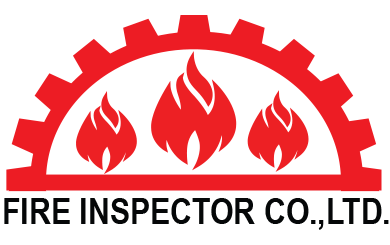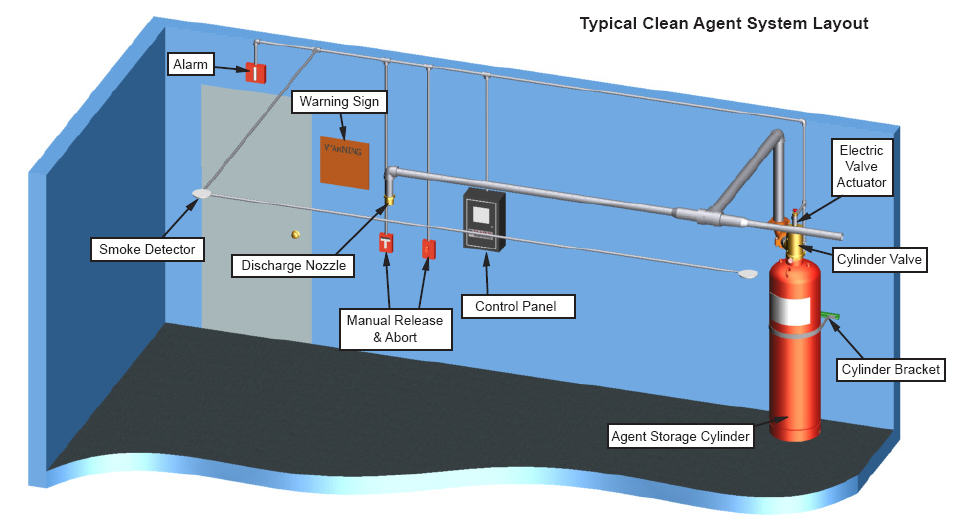สอบถามข้อมูลเพิ่มเติม
โทร 0 2026 0493
0 2026 0494
มือถือ 08 1170 0242
info.inspector@yahoo.com



FM-200 Suppression Systems
|
Description
FM-200® is a clean, colorless, and environmentally friendly fire suppression agent that is electrically non-conductive and safe for humans. It extinguishes flames primarily through heat absorption, leaving no residue, thus minimizing downtime after a fire and making FM-200 suppression systems accepted and respected worldwide with over one hundred thousand installations in more than seventy countries. |
Typical areas of fire protection
|
These systems consists of the following components and their associated accessories:
- FM-200 Storage Components – Storage components consist of the cylinder assembly(s), which contains the FM-200 chemical agent, and the cylinder bracket(s), which holds the cylinder assembly securely in place.
- FM-200 Distribution Components – Distribution components consist of the discharge nozzles used to introduce the FM-200 into a protected hazard along with the associated piping system used to connect the nozzles to the cylinder assembly.
- Trim Components – Trim components complete the installation of the FM-200 system and consist of connection fittings, pressure gauge, low-pressure supervisory switch, electric valve actuator, and manual valve actuator.
- Slave Arrangement Components – Slave arrangement components consist of the pneumatic valve actuator(s), actuation check valve, vent check, actuation hose, and fittings required for a multiple cylinder (slave) arrangement.
- Supplemental Components – Supplemental components include the discharge pressure switch and manifold check valve. They supplement the core equipment or complete a specific multi-cylinder configuration.
- Control Panel – This device monitors the condition of the electric actuator, detectors, warning devices, cylinder pressure, and any manual release and abort stations. All electric or electronic devices must connect to the control panel in order to function.
- Early Warning Detection and Alarm Devices – Early warning detection devices coupled with manual release and abort stations maximize system efficiency while audible and visual alarm devices alert staff of alarm conditions.

Equipment Description
FM-200 fire extinguishing systems are designed to be discharged within 10 seconds into a room, area, or enclosure with the structural integrity to retain the agent. The FM-200 uniformly mixes throughout the protected area achieving a minimum concentration level in accordance with NFPA 2001 and/or agency listings.
Below is a list of the Janus Fire Systems Novec 1230 fluid cylinder assemblies:
Size |
||||||
| 50 | ||||||
Chemical Properties of FM-200
FM-200® (HFC-227ea) is formed from the elements carbon, fluorine and hydrogen (CF3CHFCF3 -heptafluoropropane). The primary extinguishing mechanism of FM-200® is heat absorption, with a
secondary chemical contribution from the thermal decomposition of FM-200 in the flame.
FM-200 leaves no residue and is safe for use in occupied spaces.
Most common metals, such as aluminum, brass, steel, cast iron, lead, stainless steel, and copper, as well as rubber, plastic, and electronic components, are unaffected when exposed to FM-200
Safety Considerations
| Although the EPA Significant New Alternative Program (SNAP) lists FM-200® as acceptable for occupied spaces, NFPA Standard 2001 and SNAP list the following guidelines for human exposure:
The discharge of FM-200® into a hazard may reduce visibility for a brief period. FM-200 may cause frostbite if liquid discharge or escaping vapor contacts the skin. When FM-200® is exposed to temperatures greater than 1300°F (700°C), the by-product Hydrogen Fluoride (HF) will be formed. FM-200® systems are designed to discharge in 10 seconds or less in order to minimize the amount of HF formed. The FM-200 Material Safety Datasheet (MSDS) should be read and understood prior to A cylinder containing FM-200® should be handled carefully. The anti-recoil safety device must be in place at all times when the cylinder is not connected to the discharge piping and restrained. |
|
||||||||||||||||||||||||||||||||
Downloads
| Description | File Type | Updated |
|---|---|---|
| Sv Series System |  |
06-Feb-2015 |
| Sv Series System – español |  |
23-Apr-2014 |
| Mv Series System |  |
06-Feb-2015 |
| Mv Series System – español |  |
23-Apr-2014 |
| Lv Series System |  |
06-Feb-2015 |
| Lv Series System – español |  |
23-Apr-2014 |
| Master/Selector Valves |  |
05-Dec-2014 |
| Isolation Valves |  |
05-Dec-2014 |
(FM-200 is a registered trademark of E.I. du Pont de Nemours and Company)


